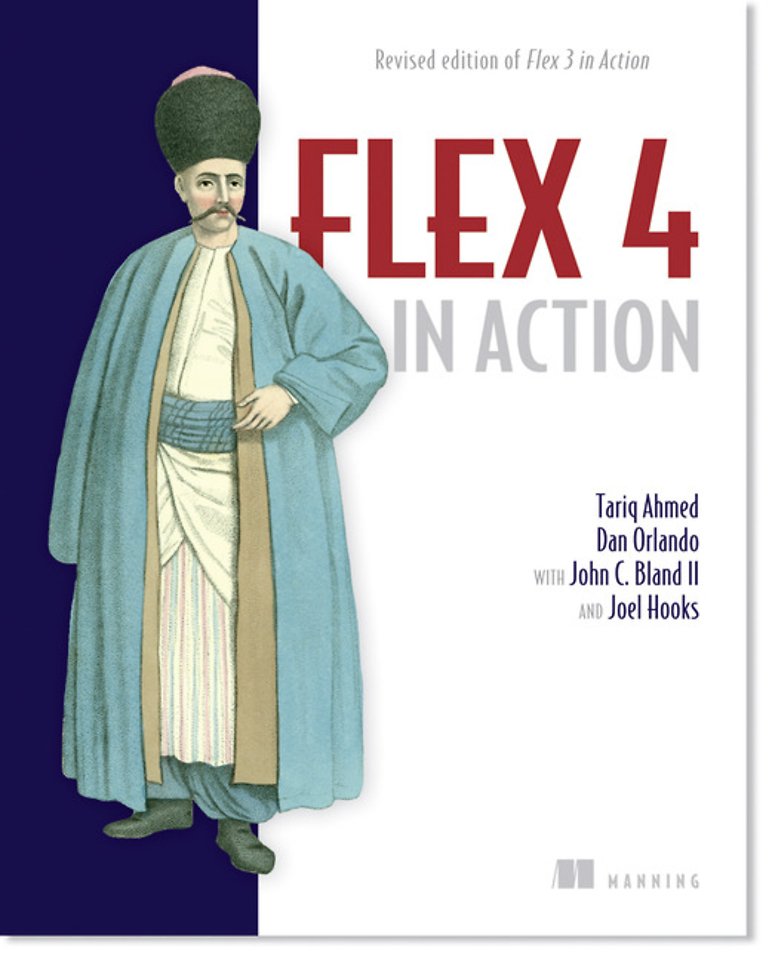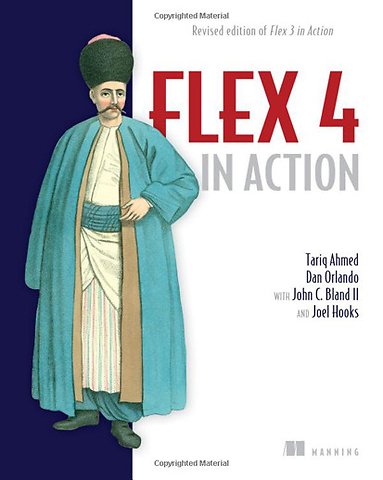


Tariq Ahmed is an accomplished web application pioneer having introduced next generation web technologies to companies such as Bell Canada and REUTERS.
Meer over de auteursFlex 4 In Action
Samenvatting
Flex has grown from just a way to build Flash apps into a rich ecosystem, and Flex 4 introduces new UI components, better performance monitoring, and speed enhancements to the compiler.
'Flex 4 in Action' is a comprehensive tutorial that introduces Flex to web designers and developers. It starts with the basics-forms and data-and moves through core concepts like navigation, drag-and-drop, and events. Even if you're new to Flex, this book is all you'll need to make your apps pop using the new Spark components, data services, charting, special effects, and more.
What's inside:
- How to architect your applications
- Use charting to build interactive dashboards
- Improve productivity with network monitoring and unit testing
- Give your apps a unique look with themes and skins
And much more
Readers of this book need basic development skills, but no previous experience with Flex.
Specificaties
Over Dan Orlando
Over John Bland II
Inhoudsopgave
Preface
Acknowledgments
About this book
About the title
About the cover illustration
Part 1: Application basics
1. Making the case
-Why are web applications so prolific?
-The RIA solution
-The RIA contenders
-Becoming acquainted with Flex
-How Flex works
-What's new in Flex 4
-Summary
2. Getting started
-Flex on the cheap
-Get serious with Flash Builder
-Exploring Flash Builder
-Views and perspectives
-Our first project—Hello World!
-Using design mode
-Built-in reference and API documentation
-MXML and ActionScript in a nutshell
-Summary
3. Working with ActionScript
-Comments
-Variables
-Loops
-Conditional statements (if statements and switches)
-Arrays
-ActionScript tidbits
-Sneak peek at functions, classes, and packages
-Simple data binding
-Summary
4. Layout and containers
-Spark versus Halo (MX)
-Absolute layout
-Constraint-based layout
-Automatic layout
-Variable and fixed sizing
-Containers
-Summary
5. Displaying forms and capturing user input
-The id attribute
-Flex's catalog of controls
-Accessing the control's value
-Summary
6. Validating user input
-Overview of validation
-Built-in validators
-Real-time validation
-Committed value validation
-Pass-through validation
-Scripted validation
-Validation tidbits
-Summary
7. Formatting data
-Built-in formatters
-Real-time formatting
-Scripted formatting
-Working with formatting errors
-Summary
8. MX DataGrids, Lists, and Trees
-MX List genealogy
-Understanding collections and the dataProvider
-Initializing collections
-Populating collections
-Interacting with MX List-based components
-Summary
9. Using the Spark List controls
-Spark List genealogy
-Spark List-based controls
-Interacting with Spark List-based components
-Understanding Flex 4 List-based component architecture
-Building custom List-based components on Spark Architecture
-Summary
10. List customization
-Customizing data display
-Item renderers
-Item editors
-Advanced item renderers
-Filter functions
-Summary
Part 2: Application flowand structure
11. Events
-The event system
-Sending and receiving events
-Custom events
-Summary
12. Application navigation
-Preparing the menu data
-Working with menus
-Using a menu bar
-Using view stacks
-TabNavigator
-Accordion
-Summary
13. Introduction to pop-ups
-Creating your first pop-up
-Controlling the window location
-Data integration with pop-ups
-Using alerts
-Summary
14. Implementing view states
-Understanding view states
-View states in Flex
-Bring it together
-Summary
15. Working with data services
-Accessing server-side data
-Action Message Format in action
-Building data-centric applications with Flash Builder
-Data-centric Flex with ColdFusion
-Data-centric Flex with Java EE and BlazeDS
-Binding the model to the view
-Summary
16. Objects and classes
-OO theory in five minutes
-Playing with objects
-Creating a class
-Working with properties
-Creating methods for your class
-Summary
17. Custom components
-Understanding Flex 4 components
-Creating simple custom components
-Skinning with the Spark Skin object
-Composite components
-Creating advanced Flex 4 components
-Get your components to communicate
-0.1 Summary 386
18. Creating reusable components
-Putting reusability into action
-Reveal gets a new look
-Runtime shared libraries
-Summary
19. Architectural design patterns
-Flex-driven design patterns
-Introduction to microarchitectures
-Using the Robotlegs framework
-Creating an application with Robotlegs MVCS
-Summary
Part 3: The finishing touches
20. Customizing the experience
-Principles of user experience design
-Visual appeal
-Interactive experience
-Business optimization
-Extensibility
-Summary
21. Working with effects
-What's an effect?
-Using effects
-Creating composite effects
-Exploring effects
-Summary
22. Drag-and-drop
-The drag-and-drop process
-Implementing drag-and-drop in Flex components
-Enter the DragManager
-Adding D&D to non-List components
-Customizing the drag-and-drop experience
-Summary
23. Exploring Flex charting
-Introduction to charting
-Setting the stage with series and data
-Creating charts
-Stacking charts
-Exploring chart types
-Customizing charts
-Summary
24. Debugging and testing
-Debugging
-Flex profiler
-Testing your applications with automation
-Summary
25. Wrapping up a project
-Customizing the HTML wrapper
-Deployment
-Summary
Bonus Chapter 26 Working with XML
Anderen die dit boek kochten, kochten ook
Net verschenen
Rubrieken
- aanbestedingsrecht
- aansprakelijkheids- en verzekeringsrecht
- accountancy
- algemeen juridisch
- arbeidsrecht
- bank- en effectenrecht
- bestuursrecht
- bouwrecht
- burgerlijk recht en procesrecht
- europees-internationaal recht
- fiscaal recht
- gezondheidsrecht
- insolventierecht
- intellectuele eigendom en ict-recht
- management
- mens en maatschappij
- milieu- en omgevingsrecht
- notarieel recht
- ondernemingsrecht
- pensioenrecht
- personen- en familierecht
- sociale zekerheidsrecht
- staatsrecht
- strafrecht en criminologie
- vastgoed- en huurrecht
- vreemdelingenrecht





